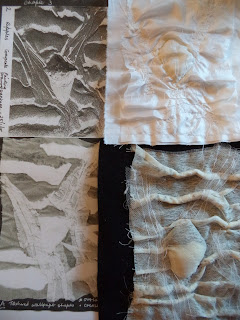These are now translated into manipulated fabrics and stitch; two for each, one soft texture the other harder texture. They show tactile contrasts using different materials and manipulated methods.
- Ripples around a pebble (see Sample 2, Ch 3)
- Pebbles on the beach (see Sample 3, Ch 3)
- Groin (barnacles on wood) (see Samples 5a, Ch 3)
- Seaweed on groin (see Sample 5b, Ch 3)
- Combined steps and paw prints (see Samples 7 & 6, Ch 3)
In order to vary the techniques, fabrics and stitches between the samples I set up an A3 sheet divided into two, labelled 1 to 5, noting on the left ideas related to soft textures, on the right harder textures. Sometimes techniques changed as I progressed so these were noted alongside the original thoughts.
1. Ripples around a pebble
2. Pebbles on the beach
3. Groin (barnacles on wood)
4. Seaweed on groin
5. Combined steps and paw prints
I particularly enjoyed making the harder textured sample for 1. and it was a good opportunity to use soldering iron and candle for the harder tactile texture for 4. I like the look and feel of the softer texture in 2. It was suggested maybe I could combine steps and paw prints to form a story which I feel these two samples divided on the diagonal show for 5., although the paw prints using wadding cut away with a soldering iron have worked better than the Tyvek bits heated using an iron and parchment paper above and below the material. The only sample not complete is the hard textured sample for 2 where pebbles were spaced and trapped behind one piece of cotton scrim, gathered using stitch at the back to prevent them escaping. The amount completed on this sample does show matching patterns for seven pebbles.
Health & Safety was kept when using the heating items: using a well ventilated room, ensuring the flex did not provide a trip hazard, the soldering iron was kept in a upturned flower pot with a glass cutting surface, and the candle held steady in a candle holder, using prongs to hold the fabric and some water at hand in a metal container to quench any flaring fabrics.







